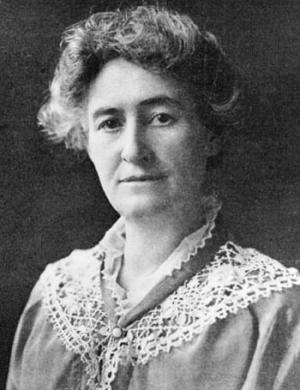- Home
- Encyclopedia
- Mary Godat Bellamy, Wyoming’s First Woman Legis...
Mary Godat Bellamy, Wyoming’s First Woman Legislator

Mary Godat Bellamy, known as “Mollie” to her friends and family, was the first woman to be elected to the Wyoming Legislature in the state’s history. She was elected to the House of Representatives in 1910 and served a single, two-year term.
Mary Godat was born December 13, 1861, in Richwoods, Mo. She moved to Laramie, Wyo., with her widowed mother in 1873. Mary later became one of the first students to attend Laramie High School. She became a teacher and taught in Nye County, Nev.; Johnson County, Wyo.; and in Laramie. In 1886, she married Charles Bellamy of Boston, Mass., a civil engineer who received the first license to practice engineering in the state of Wyoming and served as the first water commissioner under State Engineer Elwood Mead.
The couple had three sons: Benjamin and twins Fulton and Freeman. Freeman died in infancy. Both surviving sons became engineers. This connection with engineering resulted in a lake in the Snowy Range being named for Mary. Lake Marie located west of Laramie was given that name by Charles Bellamy in honor of his wife while he surveyed in the area. He named another nearby lake Bellamy Lake.
Mary, a Democrat, entered politics at least as early as 1888, when she first ran for county superintendent of schools in territorial Albany County. In 1902, she was elected to that office. As a state legislator, her record showed support for issues affecting the welfare of women and children. She sponsored changes to Wyoming’s probate laws that allowed women to serve as administrators and executors. Mary sponsored and supported bills that created industrial education programs and raised the mill levy for the University of Wyoming. She also supported legislation to implement changes in the treatment of both female and juvenile prisoners incarcerated in Wyoming penal institutions.
An active member of the Council of Women Voters and friend of Carrie Chapman Catt, prominent suffragist and founder of the League of Women Voters, Mary Bellamy was Wyoming’s envoy to the national rally for women’s suffrage in 1917. The University of Wyoming granted her a doctor of law degree in 1952. Through the efforts of the Jacques Laramie chapter of the Daughters of the American Revolution, her name was inscribed in the Memorial Bell Tower at Valley Forge. Mary Bellamy died in Laramie on Jan 28, 1955. She was 93.
Resources
Primary sources
- “Mary Bellamy Dies at 93,” Laramie Daily Bulletin, Jan. 29, 1955, 1.
- “Mrs. Mary Bellamy To Receive High Honor,” Laramie Boomerang, June. 1952, Mary Bellamy Biographical File, American Heritage Center, University of Wyoming.
- “Mrs. Mary Bellamy Visits Legislature, Laramie Republican Boomerang, Feb. 13, 1951, Mary Bellamy Biographical File, American Heritage Center, University of Wyoming.
- “Pioneer Woman Vigorous, Active On 90th Birthday,” undated, unsourced newspaper clipping, ca. December 1951, Mary Bellamy Biographical File, American Heritage Center, University of Wyoming.
Secondary sources
- Donahue, Jim, ed., Wyoming Blue Book. Cheyenne: Wyoming State Archives, Department of Commerce, 1991, vol. V, part 1, 11.
- Jost, Loren, ed., Wyoming Blue Book. Cheyenne: Wyoming State Archives, Department of Commerce, 1991, vol. IV, 247
- Roberts, Phil. “Mary Bellamy Was First Woman Elected to Wyoming State Legislature.” Wyoming Almanac of Politics: Current Events, History and Opinion. Accessed March 8, 2011 at http://www.wyomingalmanac.com/political_facts.
- Trenholm, Virginia Cole, ed. Wyoming Blue Book. Cheyenne: Wyoming State Archives, 1974, vol. II, 295 (composite House photo), 296, 402, 577, 597, 751, 753; vol. III, 65 n. (cites House Journal, 1955, year Mary B. died and was memorialized in that publication), 308.
- The five volumes of the Wyoming Blue Book, published by the Wyoming State Archives and a principal source for the Legislative Service Office’s composite narratives (see below), are also on line at http://wyoarchives.state.wy.us/BlueBooks/index.asp.
For further reading and research
- “The 19th Amendment And The Women’s Suffrage Movement.” Parker/Waichman LLP, accessed Jan. 6, 2021 at https://www.yourlawyer.com/library/19th-amendment-womens-suffrage-movement/. A Web page packed with information and useful links.
Illustration
- The photo of Mary Bellamy is from the Wyoming State Archives, negative number 1409, used with thanks.
